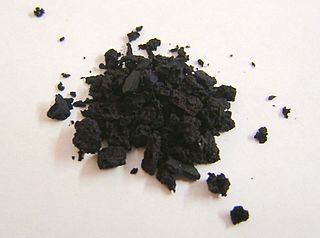
Litmus is a water-soluble mixture of different dyes extracted from lichens. It is often absorbed onto filter paper to produce one of the oldest forms of pH indicator, used to test materials for acidity. In an acidic medium, blue litmus paper turns red, while in a basic or alkaline medium, red litmus paper turns blue. In short, it is a dye and indicator which is used to place substances on a pH scale.
Irwin M. Brodo is an emeritus scientist at the Canadian Museum of Nature, in Ottawa, Ontario, Canada. He is an authority on the identification and biology of lichens. Irwin Brodo was honored in 1994 with an Acharius Medal presented to him by the International Association for Lichenology.

Lecanora is a genus of lichen commonly called rim lichens. Lichens in the genus Squamarina are also called rim lichens. Members of the genus have roughly circular fruiting discs (apothecia) with rims that have photosynthetic tissue similar to that of the nonfruiting part of the lichen body (thallus). Other lichens with apothecia having margins made of thallus-like tissue are called lecanorine.

Vainionora is a genus of lichen in the family Lecanoraceae. The genus, which was circumscribed in 1991 by German lichenologist Klaus Kalb, honours the Finnish lichenologist Edvard Vainio, who described the type species as Lecanora pallidostraminea in 1890.
Lecanora xanthoplumosella is a species of crustose lichen in the family Lecanoraceae. Known from Australia, it was described as new to science in 2011.
Lecanora mugambii is a species of crustose lichen in the family Lecanoraceae. Found in western Kenya, it was described as new to science in 2011.
Lecanora printzenii is a species of crustose lichen in the family Lecanoraceae. Originally found in Spain, it was described as new to science in 2011. It shares several characteristics with lichens of the Lecanora varia group but is differentiated by its unique sequence in the internal transcribed spacer (ITS) region of its DNA and by several distinctive physical characteristics.

Crustose lichens are lichens that form a crust which strongly adheres to the substrate, making separation from the substrate impossible without destruction. The basic structure of crustose lichens consists of a cortex layer, an algal layer, and a medulla. The upper cortex layer is differentiated and is usually pigmented. The algal layer lies beneath the cortex. The medulla fastens the lichen to the substrate and is made up of fungal hyphae. The surface of crustose lichens is characterized by branching cracks that periodically close in response to climatic variations such as alternate wetting and drying regimes.

Haematomma ochroleucum, also known as yellow bloodstain lichen, is a species of crustose lichenized fungus. First described in 1771 by Noël Martin Joseph de Necker, it has no subspecies, but two named varieties: H. o. var. ochroleucum and H. o. var. porphyrium.

Lecanora polytropa, the granite-speck rim lichen, is a species of saxicolous (rock-dwelling), crustose lichen in the family Lecanoraceae. A small, inconspicuous species that grows in the cracks of rock surfaces, it has a cosmopolitan distribution and has been recorded on all continents, including Antarctica.
Adolf Hugo Magnusson was a Swedish naturalist who specialized in lichenology. He was a school teacher in Gothenburg from 1909 to 1948, but spent his spare time on the study of lichens. He described about 900 new taxa, specializing in the genera Lecidea, Lecanora, Caloplaca, and Acarospora.
Klaus Kalb is a German lichenologist and an authority on tropical lichens.
Lecanora microloba is a species of crustose and areolate lichen in the family Lecanoraceae. Found in Poland, it was formally described as a new species in 2010 by Lucyna Śliwa and Adam Flakus. The type specimen was found by the second author in the Hińczowy Żleb gully in the High Tatra Mountains at an altitude of 2,200 m (7,200 ft). Here, in vegetation characteristic of the subnival belt, the lichen was found growing on granite rock that was mylonitized. Lecanora microloba contains secondary compounds: gyrophoric acid, usnic acid, and zeorin as major metabolites, and an unidentified terpene. A distinguishing characteristic of the lichen is the presence of coarse granules in the epithecium that are distinctly bright when shone with polarized light. The specific epithet microloba refers to the minute lobe-like areoles in the thallus margins.
Lecanora lojkahugoi is a species of saxicolous (rock-dwelling) crustose lichen in the family Lecanoraceae. It is found in the Russian Far East and in South Korea.
Lecanora vinetorum is a rare species of crustose lichen in the family Lecanoraceae. Found in Central Europe, it was formally described as a new species in 1968 by lichenologists Josef Poelt and Siegfried Huneck. The type specimen was collected from the San Michele Appiano region of Trentino-Alto Adige ; there it was found growing on vineyard frames. The species epithet vinetorum refers to its habitat.
Lecanora helmutii is a rare species of corticolous (bark-dwelling), crustose lichen in the family Lecanoraceae. Found in Tasmania, it was formally described as a new species in 2018 by Sergio Pérez-Ortega and Gintaras Kantvilas. The type specimen was collected from the eastern side of Stanley Highway, where it was found growing on the bark of Banksia marginata in a coastal swampy woodland dominated by Melaleuca. It is only known from the type collection. Other associated lichens include Austroparmelina pseudorelicina, Bactropsora paludicola, Menegazzia subpertusa, Pannaria elixii, and Parmotrema perlatum. The species epithet honours Austrian lichenologist Helmut Mayrhofer.
Carbonea aggregantula is a species of lichen belonging to the family Lecanoraceae.






